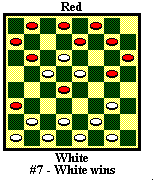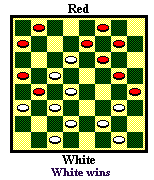Return to my Checkers pages
Go to my home page
Famous Opening Shots
© Copyright 1997 etc., Jim Loy
You may print this and show it
to others. But, this article will eventually be part of a book that I am
writing. So, please do not distribute it widely.
If you need help reading checkers notation, please print out the
numbered board.
If you don't play out these short games, you'll regret it. These are a
lot of fun. A shot, or stroke, is one or more pitches (sacrifices) followed by
one or more multiple jumps. Try to figure these out, from the diagrams.
 1.
Canalejas Shot
1.
Canalejas Shot
11-16 (Bristol) 23-18 16-20 24-19 (same as 11-16 24-19
16-20 23-18) 8-11? [diagram #1] White wins a piece: 19-15 10-19 18-14 (or 27-24
first) 9-18 22-8 4-11 27-24 WW. Montero, 1591 (A.D.). The trap is also brought
up by 12-16 23-18 16-20 24-19 (same as 12-16 24-19 16-20 23-18) 8-12?
 2.
Fool's Mate
2.
Fool's Mate
10-15 (Kelso) 23-19 6-10 22-17 11-16? [diagram #2] White
wins 2 pieces: 17-13 16-23 13-6 2-9 27-2 WW. This was named in "honor" of the
Fool's Mate in chess.
 3.
Tourist Trap
3.
Tourist Trap
9-13 (Edinburgh) 23-19 11-16 26-23 10-14 24-20? [diagram
#3] Black wins 2 pieces: 14-17 21-14 (20-11 17-26 31-22 7-31 RW) 6-10 20-11
10-26 31-22 7-31 RW. Apparently, many players have fallen for this one. This
position also comes up from 10-14 23-19 11-16 26-23 9-13 same, just before the
24-20? blunder.
 4.
Wyllie's Switcher Stroke
4.
Wyllie's Switcher Stroke
11-15 21-17 9-13 (Switcher) 25-21 8-11 17-14
10-17 21-14 6-10 22-17 13-22 26-17 15-18 24-20 2-6 28-24 4-8 29-25 11-15 30-26
6-9? (15-19 draws) [diagram #4] This one is a little tougher than the above
traps: 24-19 15-24 20-16 12-19 27-20 18-27 31-6 1-10 26-22 9-18 22-6 WW, James
Wyllie.
 5.
Steel Shot
5.
Steel Shot
11-15 23-19 8-11 22-17 9-13 17-14 10-17 21-14 (Laird &
Lady) 15-18 19-15 4-8 24-19 13-17 28-24 11-16 26-23 16-20 31-26? [diagram #5]
An impressive shot follows: 18-22! 25-18 12-16 19-12 7-10 14-7 3-28 12-3 2-7
3-10 6-31 RW, James Steel, published in 1851.
 6.
Boomerang Trap (A. J. Heffner - J. Hill) (White comes up with a clever
shot, but Red wins)
6.
Boomerang Trap (A. J. Heffner - J. Hill) (White comes up with a clever
shot, but Red wins)
11-15 24-19 (Second Double Corner) 15-24 28-19 9-14
22-18 5-9 26-22 7-11 27-24 3-7 22-17 11-15 18-11 8-15 25-22 9-13 (Now, White's
shot) 23-18 14-23 17-14 10-26 19-3 [diagram #6] Now, Red wins a piece: 12-16!
31-22 16-20, then if 24-19 2-7 RW. This was A. J. Heffner - J. Hill, which
continued (after Red's 16-20) 3-7 2-11 24-19 11-15 19-10 6-15 21-17 4-8 17-14
8-12 14-10 12-16 10-7 15-19 7-2 23-26 30-23 19-26 2-7 26-30 22-18 30-26 18-15
RW.
 7.
Saukell's Shot
7.
Saukell's Shot
11-15 23-19 8-11 22-17 9-13 17-14 10-17 21-14 (Laird
& Lady) 15-18 19-15 4-8 24-19 6-9 15-10 13-17 19-15 17-21 28-24 11-16
[diagram #7] White kings a piece for an easy win: 15-11 8-15 10-6 1-17 25-22
18-25 29-6 2-9 24-19 WW, Saukell. Red will not be able to king.
 8.
Goose Walk
8.
Goose Walk
11-15 22-18 (Single Corner) 15-22 25-18 8-11 29-25 4-8 25-22
10-15 24-20 12-16 27-24? [diagram #8] Red drastically changes the position with
the following shot, but remains even in material. Can he win, when it's over?
16-19 (or 15-19 first) 23-16 15-19 24-15 9-14 18-9 11-25 and 5-14. Apparently,
since White cannot king, Red can just wait with 25-29-25-29... until White lets
him out of the corner, RW.
 9. A
Hole in the Dyke
9. A
Hole in the Dyke
11-15 22-17 15-19 (Black Dyke) 23-16 12-19 24-15 10-19
25-22 8-11 29-25? (27-23 or 30-25 PP) 11-15 27-23? (17-13! PP) [diagram #9] Red
comes out even in material, with this shot. Can he win when it's over? 9-13
23-16 15-18 22-15 13-29 21-17 4-8 (Red can win a piece with 7-11, but can he
keep it?) If Red is careful, White will run out of moves, RW, W. F. Ryan.
 10.
Scrub's Delight
10.
Scrub's Delight
11-15 23-19 8-11 22-17 4-8 (Old 14th. Or 9-14 17-13 4-8
26-23 15-18 24-20 11-15 17-13 8-11 same) 17-13 15-18 24-20 11-15 28-24 8-11
26-23 9-14 31-26 6-9 13-6 2-9 26-22 9-13 [diagram #10] Again, White comes out
even in material: 20-16 (or 22-17 first) 11-20 22-17 13-22 21-17 14-21 23-14
10-17 25-22 WW. OK, can you win this for White? Continue: 1-6 (now or later)
2-9 5-14 19-15 3-8 (14-18 24-19 and 27-24 WW) 15-10 8-11 10-6 11-15 6-2 12-16
(17-22 2-6 14-18 6-10 WW) 2-6 14-18 6-10 16-19 10-14 19-28 14-23 17-22 23-18
WW. This is called "the big stroke" in Lees' Guide, and there it is credited to
J. Sturges.
These two shots occur in the ending:
 11.
Brooklyn
11.
Brooklyn
11-15 22-18 (Single Corner) 15-22 25-18 9-13 29-25 12-16 18-14
10-17 21-14 16-20 23-18 6-10 25-21 10-17 21-14 1-6 26-23 13-17 31-26 8-11 24-19
4-8 28-24 8-12 19-15 3-8 23-19 11-16 26-22! 17-26 30-23 7-10 14-7 2-11 [diagram
#11] This is called the Brooklyn Position: 18-14 11-18 14-10 6-15 23-14 16-23
27-4 20-27 32-23 WW, John Drummond.
 12.
Alligator (or Crocodile) Position
12.
Alligator (or Crocodile) Position
9-13 (Edinburgh) 22-17 13-22 25-18
11-16 29-25 5-9 18-14 9-18 23-14 10-17 21-14 8-11 24-19 16-23 26-19 6-10 25-21
10-17 21-14 11-16 28-24 16-23 27-18 7-11 30-26 11-16 26-23 16-20 31-27 2-7
24-19 7-11 14-10 11-16 18-15 4-8? [diagram #12] Now, White maneuvers quietly
for a surprise shot. Fishburne called this the Alligator Position, "because it
has such a wicked tail-end snap." 10-6 1-10 15-6 3-7 6-2 7-10 2-6 10-14 6-9
14-17 9-14 17-22 14-17 22-26 32-28* 26-31 (8-11 28-24 26-31 17-22 WW) 19-15
31-24 28-19 20-24 23-18*! (the snap of the tail) 16-23 15-11 8-22 17-28 WW, W.
H. Russell.
Addendum #1: More Opening Shots
 13.
Don - Amateur
13.
Don - Amateur
11-15 22-18 15-22 (Single Corner) 25-18 8-11 29-25 4-8
25-22 11-16 18-15 10-19 24-15 9-13? [diagram #13] White wins a piece: 15-10
7-14 (or 6-15) 22-17 13-22 26-10 6-15 23-19 WW.
 14.
Pringle - a friend
14.
Pringle - a friend
11-15 21-17 8-11 (9-13 is stronger) 25-21 (this
position is more natural from 11-15 22-17 8-11 25-22) 4-8 (9-13) 24-20 15-18
22-15 11-18 23-14 9-18 29-25 8-11 28-24? [diagram #14] Maybe you can find this
win: 18-23! 26-19 (27-18 10-14 is shorter) 11-16 20-11 7-23 27-18 10-14 17-10
6-29 RW.
Extra credit: Did you notice that diagrams 13 and 14 are nearly
identical (but colors reversed)? The winning moves are the same.
 15. The
Jacques Shot: Campbell - E. R. Jacques, 1869
15. The
Jacques Shot: Campbell - E. R. Jacques, 1869
9-13 24-19 11-16 22-18
8-11 28-24 16-20 18-14(A) 10-17 21-14 11-16 25-21 6-9 23-18 16-23 26-19 4-8?
(13-17 is strong, PP) 29-25 7-11(B) 19-15 (25-22) 13-17 (12-16) 31-26 9-13
25-22 12-16 15-10 2-7? (16-19! 24-15 2-7 27-24 20-27 32-23 5-9 draws, W.Ryan)
[diagram #15] Find the win: 27-23! 20-27 14-9 5-14 18-9 7-14 9-6 1-10 23-18
21-7 3-10 26-3 27-31 3-7 WW.
A - Boland's Masterpieces in the Game of Checkers gives this game
as beginning: 11-16 24-19 8-11 28-24 16-20 22-17 9-13 22-17 9-13 17-14
same.
B - Boland's Masterpieces in the Game of Checkers says 13-17
31-26 9-13 25-22 7-11 19-15 same.
Addendum #2: Two shots from Checkers (also called Win
at Checkers) by Millard Hopper.
 16.
Page 82
16.
Page 82
11-15 23-18 8-11 27-23 11-16 (Slip Cross) 18-11 16-20 24-19
7-16 22-18 4-8 25-22 8-11 29-25 10-14 19-15 3-8 22-17? (31-27 draws) [diagram
#16] Red wins with 20-24! 28-19 16-20 17-10 9-14 18-9 11-27 32-23 6-24 RW.
 17.
A draw, page 83
17.
A draw, page 83
11-15 24-20 (Ayrshire Lassie) 8-11 28-24 4-8 23-19 9-14
22-17 5-9 26-23 9-13 20-16 [diagram #17] Red can draw this, believe it or not:
11-20 (13-22? 25-9 6-13 30-25 11-20 21-17 13-22 25-4 WW) 30-26 13-22 25-4 10-17
21-14 3-8 4-11 7-30 14-10 (did you see that coming?) 6-15 31-26 30-23 27-11
20-27 32-23 draw. Eighteen pieces disappeared in one shot.
 18. From The Complete Guide to Checkers (also titled
Secrets of Checkerboard Strategy) by Tom Wiswell
18. From The Complete Guide to Checkers (also titled
Secrets of Checkerboard Strategy) by Tom Wiswell
11-15 23-18 9-14
(Cross Choice) 18-11 8-15 22-17 4-8 25-22 8-11 27-23 11-16 24-19 15-24 28-19
16-20 31-27? (32-27 draws, Wiswell) [diagram #18]. Red wins with 14-18! 22-15
(or 23-14 5-9 is similar) 7-11 15-8 10-14 RW.
 19.
Here is a shot from Lees' Guide
19.
Here is a shot from Lees' Guide
11-15 24-20 (Ayrshire Lassie) 8-11
28-24 4-8 23-19 15-18 22-15 11-18 26-22 7-11 22-15 11-18 30-26 8-11 26-22?
[diagram #19]. Red wins with 11-16! 20-11 3-7 22-15 7-23 27-18 10-28 RW.
Return to my Checkers pages
Go to my home page
 1.
Canalejas Shot
1.
Canalejas Shot 2.
Fool's Mate
2.
Fool's Mate 3.
Tourist Trap
3.
Tourist Trap 4.
Wyllie's Switcher Stroke
4.
Wyllie's Switcher Stroke 5.
Steel Shot
5.
Steel Shot 6.
Boomerang Trap (A. J. Heffner - J. Hill) (White comes up with a clever
shot, but Red wins)
6.
Boomerang Trap (A. J. Heffner - J. Hill) (White comes up with a clever
shot, but Red wins) 7.
Saukell's Shot
7.
Saukell's Shot 8.
Goose Walk
8.
Goose Walk 9. A
Hole in the Dyke
9. A
Hole in the Dyke 10.
Scrub's Delight
10.
Scrub's Delight 11.
Brooklyn
11.
Brooklyn 12.
Alligator (or Crocodile) Position
12.
Alligator (or Crocodile) Position 13.
Don - Amateur
13.
Don - Amateur 14.
Pringle - a friend
14.
Pringle - a friend 15. The
Jacques Shot: Campbell - E. R. Jacques, 1869
15. The
Jacques Shot: Campbell - E. R. Jacques, 1869 16.
Page 82
16.
Page 82 17.
A draw, page 83
17.
A draw, page 83 18. From The Complete Guide to Checkers (also titled
Secrets of Checkerboard Strategy) by Tom Wiswell
18. From The Complete Guide to Checkers (also titled
Secrets of Checkerboard Strategy) by Tom Wiswell 19.
Here is a shot from Lees' Guide
19.
Here is a shot from Lees' Guide